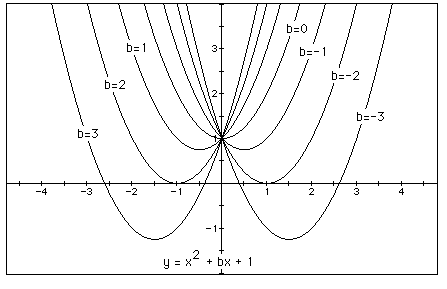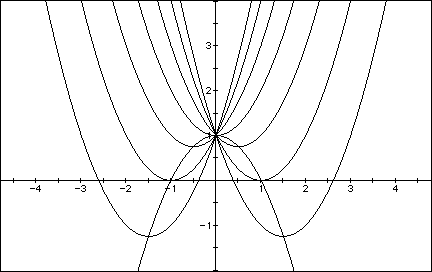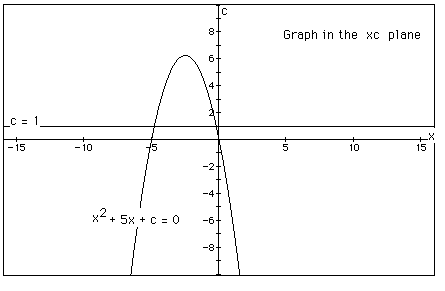The Department of Mathematics Education
Some Different Ways to Examine

by
James W. Wilson and William G. Daly
University of Georgia
It has now become a rather standard exercise, with available technology, to construct graphs to consider the equation
![]()
and to overlay several graphs of
![]()
for different values of a, b, or c as the other two are held constant. From these graphs discussion of the patterns for the roots of
![]()
can be followed. For example, if we set
![]()
for b = -3, -2, -1, 0, 1, 2, 3, and overlay the graphs, the following picture is obtained.

We can discuss the "movement" of a parabola as b is changed. The
parabola always passes through the same point on the y-axis ( the point (0,1)
with this equation). The reason for this is apparent by inspecting the
quadratic equation; this is the y intercept found by setting x=0 and will
always be the point (0,c). For b
< -2 the parabola will intersect the x-axis in two points with positive
x values (i.e. the original equation will have two real roots, both positive).
For b = -2, the parabola is tangent to the x-axis and so the original equation
has one real and positive root at the point of tangency. For -2 < b <
2, the parabola does not intersect the x-axis -- the original equation has
no real roots. Similarly for b = 2 the parabola is tangent to the x-axis (one
real negative root) and for b > 2, the parabola intersects the x-axis twice
to show two negative real roots for each b.
Now consider the locus of the vertices of the set of parabolas graphed from
![]() .
.
The locus of points followed by the vertex of this parabola can be found by recalling that the x value of the vertex is ‑b/(2a). Substituting this into x in the quadratic yields the y value at the vertex:
![]()
or an ordered pair at the vertex of the parabola:

Solve for b at each of these ordered pair values by manipulating
![]()
and
![]() .
.
Solved for b, these two equations are:
![]()
and
![]() .
.
Of course, b(x) = b(y), so setting these two equations equal and solving for y gives the equation for the locus of points for the vertices of the family of parabolas:
![]()
Squaring both sides and simplifying results in a general expression for the locus of vertices of a parabola , y=c-ax2. In our example, a=c=1, leaving the expression for the locus of vertices:
![]()

Graphs in the xb plane.
Consider again the equation
![]()
Now graph this relation in the xb plane. We get the following graph.

If we take any particular value of b, say b = 3, and overlay this equation on the graph we add a line parallel to the x-axis. If it intersects the curve in the xb plane the intersection points correspond to the roots of the original equation for that value of b. We have the following graph.

For each value of b we select, we get a horizontal line. It is clear on a
single graph that we get two negative real roots of the original equation when
b > 2, one negative real root when b = 2, no real roots for -2 < b
< 2, One positive real root when b = -2, and two positive real roots
when b < -2.
Consider the case when c = - 1 rather than + 1. It is clear from this graph that for c=
-1, there are real roots for any value of b. Notice that the roots in this case are
always opposite in sign.

The behavior of these graphs is illuminated by examining the quadratic formula for a=1 and c=+1:
For c=1:
![]()
and for c=-1,
![]() .
.
Notice in the second expression that the expression under the radical can never be negative for any value b, whereas in the first expression, the range –2<b<2 results in no real solution.
In addition to the algebraic interpretation of the graphs in the xb plane, there is also a geometric interpretation. Consider the same graph shown below in the xb plane, only now with the addition of the line b=-2x.

This line represents the case where the radical in the quadratic formula is
zero. Where b=-2x intersects the
locus of roots in the xb plane, at (-1/2, 2) (1/2,‑2), represents a
single root. As one moves further along
the line b=-2x, the roots are moving, equidistant in the horizontal
direction, off of the b=-2x line. This
corresponds to the + in front of the radical in the quadratic formula. For one value of b=4, this is shown
by arrows in the graph
Graphs in the xc plane.
In the following example the equation
![]()
is considered. If the equation is graphed in the xc plane, it is easy to see that the curve will be a parabola. For each value of c considered, its graph will be a line crossing the parabola in 0, 1, or 2 points -- the intersections being at the roots of the original equation at that value of c. In the graph, the graph of c = 1 is shown. The equation
![]()
will have two negative roots -- approximately -0.2 and -4.8.

There is one value of c where the equation will have only 1 real root -- at c = 6.25. For c > 6.25 the equation will have no real roots and for c < 6.25 the equation will have two roots, both negative for 0 < c < 6.25, one negative and one 0 when c = 0 and one negative and one positive when c < 0. To relate this graph to the quadratic formula, notice that the expression under the radical (b2-4ac) for this equation is 25-4c. Consider what happens when this expression is greater than 0, equal to 0 and less than 0. Solving for 25-4c=0 results in c=6.25, which agrees with the observation from the graph that there is one real root at c=6.25. This make sense since this is where the radical disappears and all that remains is –b/2a. When the value of c>6.25, the expression under the radical is negative, hence no real roots.
